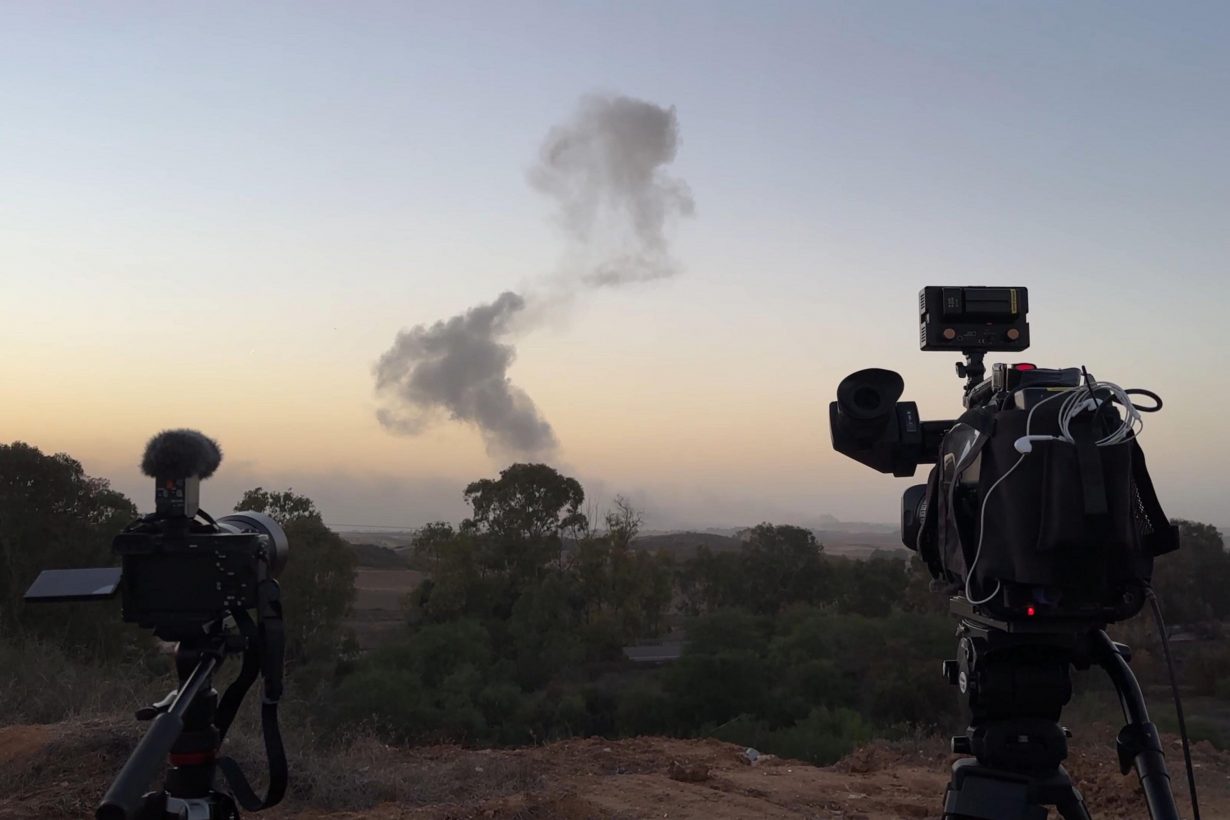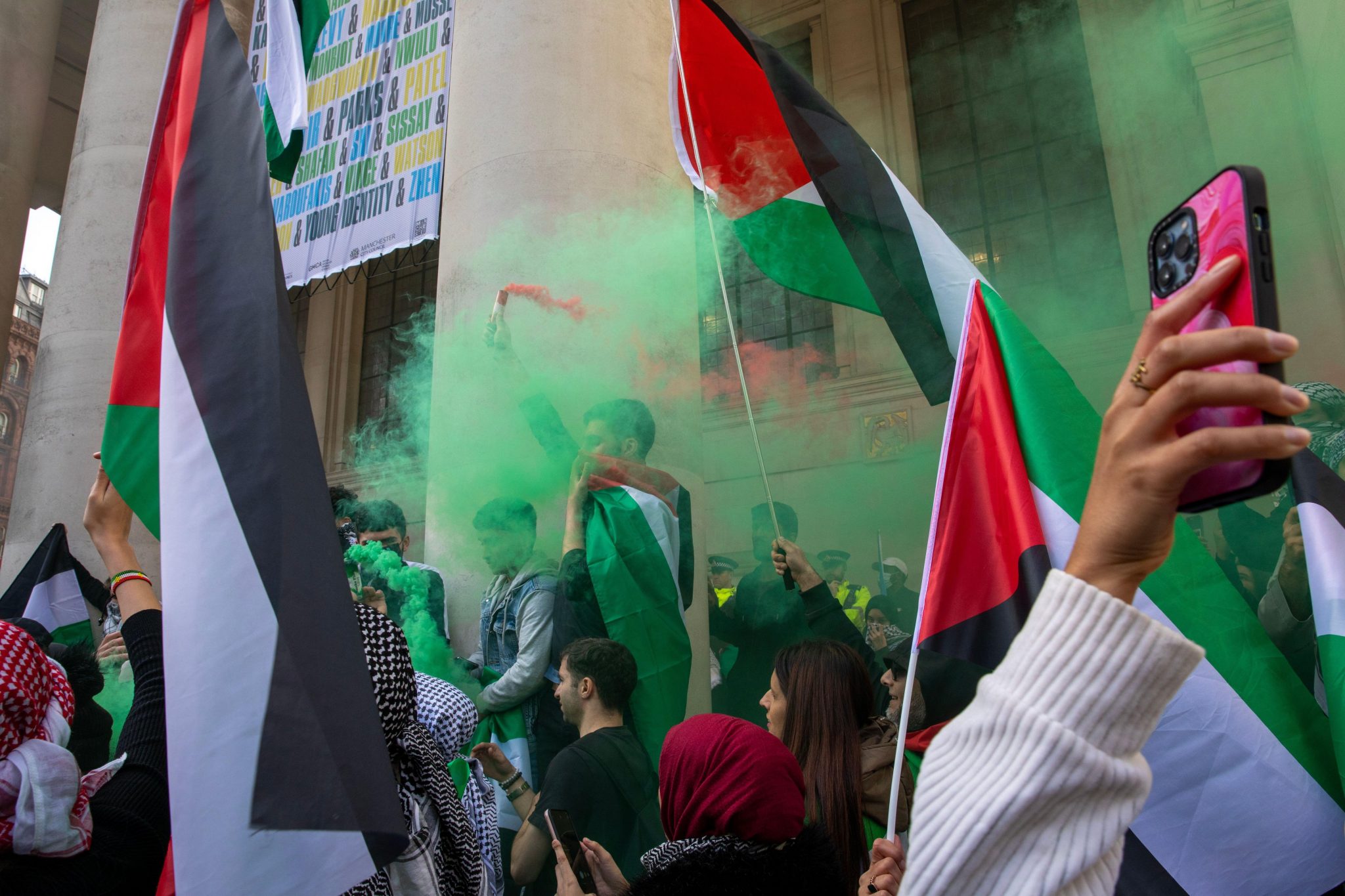The bombardment of Gaza presents a new context for a recurring condition – and the complicated relationship between sharing or engaging with something on social media, and taking ‘meaningful’ political action
In early December, several photographs and videos circulated on my Instagram feed, of groups of Palestinian men stripped to their underwear, blindfolded, and presided over by armed IDF soldiers. In one photograph, the men are being made to kneel in what looks like a desert landscape, hands tied behind their backs. In one of the videos, the camera pans along a city street; row after row of men sit huddled in the middle of the road, and as the clip ends we see them being marched on to the back of an open truck.
These particular images from Gaza were allegedly taken by members of the IDF and shared by Israeli media outlets, including Walla News (it is unclear how else they might have been documented or initially distributed), and the posts that I saw on social media tended to be captioned or overlaid with text. They are unnervingly reminiscent of the infamous images of torture at the Abu Ghraib prison in Iraq that emerged in 2004, both in the debasing nature of what the subjects of the photographs and videos are being forced to endure, and because part of what makes the imagery so chilling is that it has, we infer, been recorded by the perpetrator.
In the Abu Ghraib photographs taken by US soldiers, the most disturbing feature was their sense of play, and a lightness evocative of capturing a memento. Smiling US Army soldiers posed with captives as if they were tourist attractions: in one, first broadcast on CBS, a soldier can be seen pausing, camera in hand, to admire the images he has already taken. The newer images from Gaza shared by Israeli media are of course unique but nonetheless echo similar power dynamics. They read as a ‘blatant attempt at the humiliation & degradation of Palestinian men… stripped & displayed like war trophies’, the Palestinian politician and scholar Hanan Ashrawi wrote on Twitter/X.
If humiliation and degradation were the original intent of these recent images, this was not the reason that I, 2000 miles away from Gaza, was seeing them on my feed. Instead, as captions and text later overlaid by users tended to make clear, they were being shared in condemnation, to provoke outrage. But does an image reshared in opposition to its original intent perpetuate the initial violation of its subject? I asked a friend why he had shared one of the videos. He felt that it showed, above anything else, the monstrosity of the person who had created it. This reply initially made me uneasy. It feels fair, and maybe even true, but is also centred around the (in this case Western) viewer’s experience of the image. Ultimately, Palestinian men are still the subjects of the images, so clearly recognisable in some cases that people were able to identify brothers, nephews, friends and colleagues. In this well-meaning act of online provocation, the individuality and privacy of these men’s suffering is arguably sacrificed: they become an object, a vector for a wider condemnation.
The bombardment of Gaza presents a new context for this recurring condition of objectification. The Israeli author and curator Ariella Azoulay’s influential 2008 book, The Civil Contract of Photography, suggests that the emphasis being placed on the viewer is crucial. For Azoulay, photographs are ‘transit visas’ which de-territorialise citizenship: in looking at a photograph we become a witness, we – having instead become part of a kind of citizenry of photography – are bonded to its subject and responsible for what we see. Furthermore, Azoulay credits the presence of a camera at the site of abuse or violence as an additional gaze. In this reading, even when the photographer is the perpetrator of the violence, the camera lets the subjects of a photograph address a possible future spectator, beyond the horror of the present. As such, for the Palestinian men in the photographs, the camera becomes a kind of portal: they know that what they are being subjected to is not contained in a private present under the lone watch of the IDF forces. It also means that, by viewing the photograph, we are accountable to the men.

Across 2017 and 2018, debates erupted around the work of the artists Dana Schutz and Luke Willis Thompson and the production, exhibition and distribution of controversial images. Schutz is a white American artist whose 2016 painting Open Casket – of the funeral of Emmett Till, a Black 14-year-old who was tortured and lynched in 1955 – was included in the 2017 Whitney Biennial. Willis Thompson, a New Zealander described as a ‘white-passing male’ by the artist and writer Rene Matić, has made works that centre around racially motivated police brutality – including his Turner prize-nominated Autoportrait (2017), a portrait of Diamond Reynolds, whose boyfriend Philando Castile was killed by a police officer in 2016. Race was at the forefront of discussions initiated by writers like Matić, particularly with regard to who gets to be an artist, who or what is an appropriate subject, and who gets to profit – both in the sense of the commodification of the work that Schutz and Willis Thompson produce – even more so if their destiny is the walls of a private collector – and of these works advancing their artistic careers.
There was also a subtler point about the work of Schutz: Open Casket was based on a photograph. Emmett Till’s mother, Mamie Till Mobley, upon seeing the brutally disfigured body of her murdered son, requested an open coffin funeral and a public viewing, at which she permitted photographs to be taken. As Claudia Rankine has written: ‘Mobley’s refusal to keep private grief private allowed a body that meant nothing to the criminal-justice system to stand as evidence.’ The photographs could be said to be part of this ‘evidence’. By appropriating one, and subjecting it to her own artistic interpretation, Schutz breached the gravity of the original image, and subverted its role in carrying out Mamie Till Mobley’s wish that we bear witness to what was done to her son.
These discussions, it must be underlined, related mostly to the direct context of the gallery and the wider context of the artworld. Social media is a space where time, context and intent become flattened and distorted in feeds rooted not in chronology or location, but curated by customised algorithms – the primary aim of which is engagement for revenue. In ‘Naturalized’ (2023), an extraordinary poem by the Palestinian-American poet and writer Hala Alyan, a diasporic speaker parses their own position within the realities of multiple presents: ‘The newspaper says truce and C-Mart/ is selling pomegranate seeds again. Dumb metaphor./ I’ve ruined the dinner party. I was given a life. Is it frivolous?’ For the disorientating back-and-forth effect it produces – internal half rhymes daisychain between enjambed sentences; subjects are picked up, dropped or interrupted, picked up again – Alyan’s poem is also one of the best simulations of a social media feed that I have encountered, where in seconds you can scroll, as Alyan writes, through ‘brunch’, a ‘beach vacation’ and ‘a missile fist-bumping the earth’.
Conversations about taking ‘activism’ to social media quickly become paradoxical. Media bias and misinformation are part of why our urge to post can feel necessary; most platforms are billionaire-owned and it is a deeply unregulated space influenced by political actors and advertising money, and one that rewards virality and instant gratification over accuracy. Users now have unprecedented agency in Azoulay’s ‘civil contract’ – as she wrote in a recent essay for Hyperallergic: ‘The horror of the Nakba repeats on our screens, broadcast directly by its victims, who also send testimonies.’ But reaction to this is very constricted by the format of the media: What does it mean to like a photograph of a child’s corpse in a bodybag? And in a constant stream of images, how do we give these specific images the weight they deserve as evidence?
The relationship between sharing, posting or engaging with something on social media, and taking ‘meaningful’ political action is complicated, and they are not necessarily discrete activities. There is one logic that sharing a post can act as an easy, flimsy substitute for real action, but in an era in which social media is part of the fabric of reality, what constitutes ‘real’ action feels increasingly hard to define. Instagram, for instance, has played a role in helping coordinate national marches and actions in support of Palestine in the UK, a tangible example of shares and likes translating into in-person participation, and what would have classically been considered protest or action. But it gets tricky to draw a clear line here. Many users document their attendance at the marches and then post the photographs to Instagram, so that in effect the protest happens both on the streets and on social media. And if one of the purposes of a protest march is to build solidarity, raise awareness and show support, it would be difficult to argue that this isn’t at least partly achieved through social media too.
Then there is time, which gets warped not just on the feed itself, but in the extremely condensed timeline that now exists between the moment an event occurs and when an image gets circulated. Those images from Abu Ghraib were first aired on CBS news in April 2004, when Amnesty International had already been condemning human rights abuses by the US military in detention centres in Iraq for nearly a year. Today, an atrocity can be broadcast directly by its victims, making action or response perhaps more imperative, in the sense that what is happening can still be stopped.
Some possible means of giving the correct weight to these images might lie in the work of the research group Forensic Architecture, who since 7 October, in collaboration with Al Haq’s Forensic Architecture Investigation Unit, have been conducting ongoing analysis of the destruction of medical infrastructure in Gaza. (By the World Health Organisation’s record there have already been over 240 attacks on medical facilities, each one a potential war crime). To do this, Forensic Architecture have cross-referenced and analysed hundreds of reports from Al-Jazeera, Al Araby and Shehab News, alongside photographs posted by users on Twitter, Instagram, TikTok and Telegram. On their website, you can access a fastidiously compiled, damning timeline of hospital attacks, mapped through social media: each post is given the dignity of being witnessed, and treated as evidence in the construction of action.
Holly Connolly is a writer based in London. Her work has appeared in the Paris Review, the LRB and Jacobin, among others.
